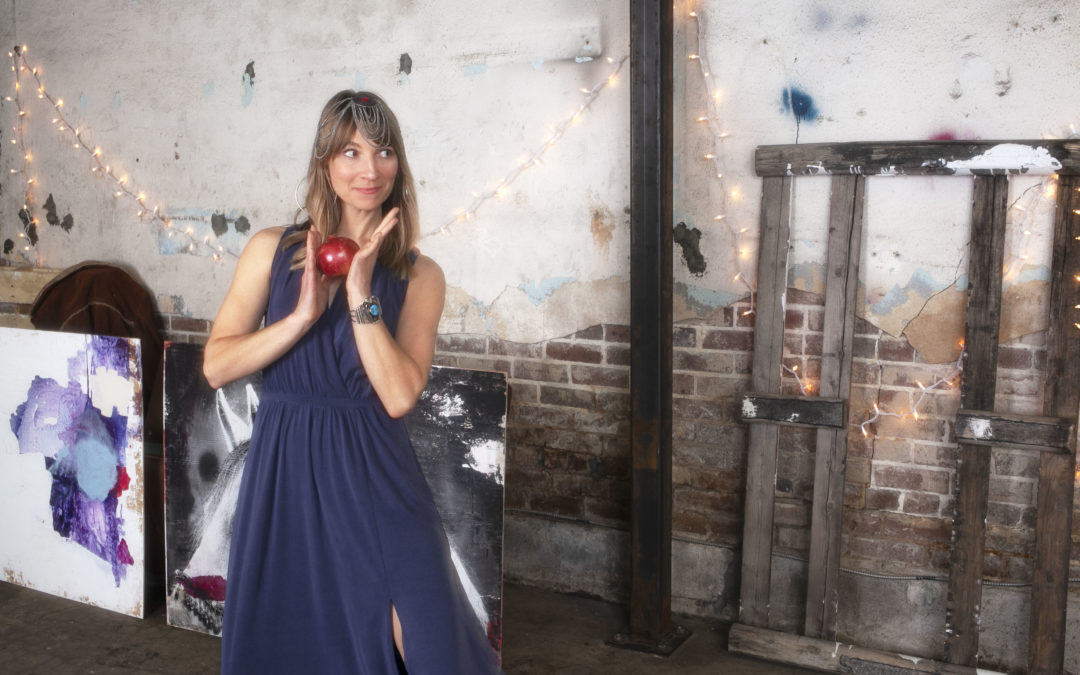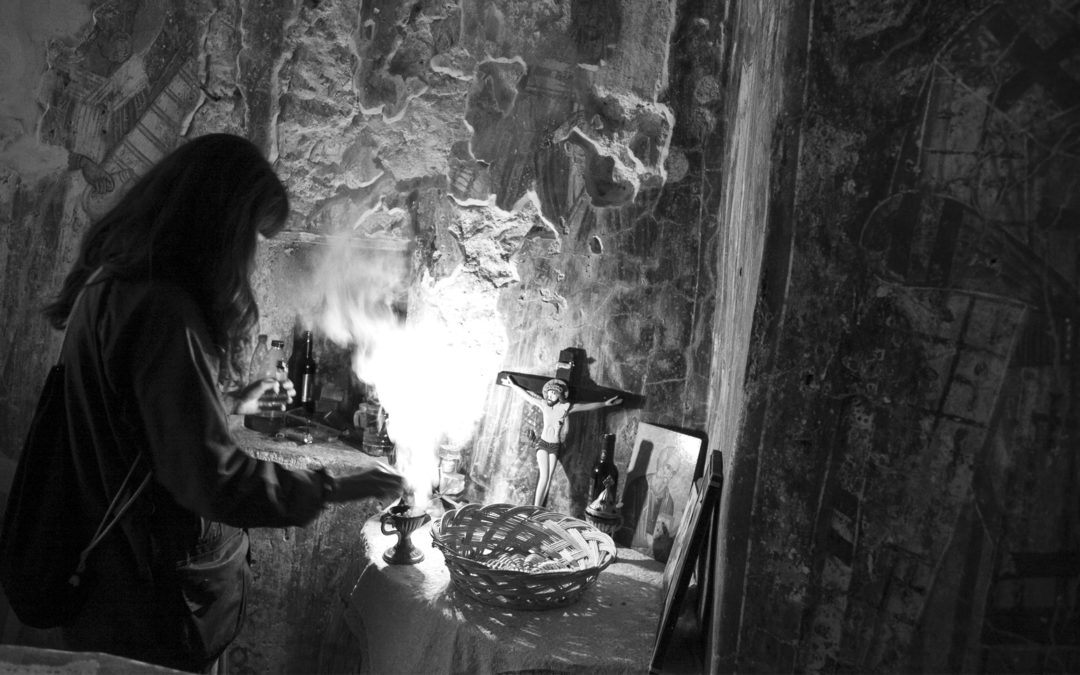
by Kosmic Tonic | May 17, 2019 | Astrology
We’re so lucky to work with a community of talented and supportive women. Today we’re featuring writing from one of our good friends and collaborators, Colorado-based psychotherapist and all round magic lady: Kestrel Neathawk.
Where the light meets the water and everything begins to shimmer—it’s an ethereal and alchemical space, where Aphrodite, The Alchemical Goddess, wandering between my 12th and 1st whole sign houses, craves to be. If you stand just so, the Sun gently kisses your face with warmth. The leaves are backlit, in the caressing morning light—making it possible to see the network of veins coursing through translucent green. For a brief moment, in harmony with the elements that surround—water, earth, air, fire—Venus on the horizon embarks on a seemingly magical transformation from dark to light, visible then invisible. And before the Sun’s rays become too powerful, you might see her in a strand of a spider web—spanning between two trees or stalks of thistle—turning the delicate threads to silver and gold. It is in this moment that my very cellular make-up is also affected, my heart sings and the outward expression ignites a smile upon my face—a giggle if you listen closely. An inner glow transmuted outward. Peace washes over me. I feel at one with the Cosmos.
In Jean Shinoda Bolen’s book, Goddesses in Everywoman: A New Psychology of Women, she refers to Aphrodite as the Alchemical Goddess and what I am describing above is the golden light of Aphrodite Consciousness. Bolen states, “What is in the ‘limelight’ absorbs our attention. We are drawn effortlessly toward what we see, and we are relaxed in our concentration…It is in her style to be genuinely and momentarily involved in whatever interests her.” Bolen goes on to say, that Aphrodite Consciousness is neither “focused consciousness” nor “diffuse awareness,” that the Virgin Goddesses (Artemis, Athena and Hestia) and Vulnerable Goddesses (Hera, Demeter and Persephone) possess. Aphrodite Consciousness is “a third mode of operation” and naturally brings-to-mind my work as a psychotherapist and budding astrologer. Psychotherapy is a complex art of listening deeply (beholding). It requires the beholder to make associations/connections while also keeping in mind the complex cosmology of the client—incorporating/balancing/weighing their past, present, personal narratives, cultural backgrounds, internal archetypes coupled with the psychotherapist or astrologer’s own emotional response to the information being conveyed. It has been my experience, that when a client comes to me, there is a desire to be seen and ultimately change. Something isn’t working anymore or must be integrated and understood differently in order to proceed forward on whatever the individual evolution is calling for. While doing work with clients, it helps me to picture an infinite, divine and unique Universe inside of each individual (the natal chart) while simultaneously reminding myself that I’m only getting a small snapshot of the larger picture, yet I am also involved in a reciprocal process of interchange that requires the combination/mixing of two souls. Honest and vulnerable, I am also being touched in equal parts by my client. The transformational process is a balancing act, as it requires both healthy boundaries to minimize transference/countertransference, but enough receptivity to invite attunement, compassion and resonance, in order for the client to feel safe enough to invite openness in the process. Jung noted that the therapeutic (or analysis) deeply affected both the client and therapist: “For two personalities to meet is like mixing two different chemical substances. If there is a combination at all, both are transformed.”
“Whenever Aphrodite consciousness is present, energy is generated: lovers glow with well-being and heightened energy; conversation sparkles, stimulating thoughts and feelings. When two people truly meet each other, both receive energy from the encounter and feel more vitality than before, regardless of the content—which, in therapy (or the astrological consult), can be very painful material. Work becomes invigorating rather than draining. Absorbed by whom we are with, or by what we are doing, we lose track of time—a characteristic that Aphrodite shares with Hestia.” ~Bolen

by Kosmic Tonic | May 9, 2019 | Astrology
When did we learn to fear snakes?
The Hebrew name for Eve, Hawwah (or Havvah or Chavah) has been translated to “mother of all living,” or simply “life” or “breath.” But scholars have also traced the etymology to words for serpent, possibly from the Phoenician snake goddess Havat, or the term for beast of the field, chevya.
As Mary Condren writes in The Serpent and the Goddess, snakes mediate the relationship between the divine feminine and human culture. I think of the Minoan snake-goddess figurines found at archaeological sites in Crete or the Egyptian Wadjet, a serpent-moon Goddess, or Lilith, the scapegoat for all feminine wickedness (/ bad-assery.) Some histories credit snakes with helping the Sun rise. A winged serpent was carved onto the tomb of Rameses VI with the words: “She who causes to rise before Re. It is She who leads the Great God in the gate of the Eastern horizon.”
Snakes are inherently regenerative, and for this reason, they represent cycles of death and rebirth. Regrowth. Serpents slough their old skin as women shed their uterine lining once a month. Perhaps for this reason too, snakes represent a particular, inner wisdom—what Jung called gnosis: a “thinking from the intestines… a knowledge that comes from the blood.”
Maybe because her head is inseparable from her heart or her tail, the Serpent bridges paradox. The biblical snake leads us from innocence to experience; the Serpent in the Egyptian Book of the Dead wavers between “loving and hating the gods.” This wavering is internalized in the Hebrew letter connected to Serpent: Teth (ט). One Hebrew learning site describes Teth as a paradoxical letter, for its inverted form “reveals both good and evil.” Interestingly, this letter has been assigned to one of the Tarot’s more feminine major arcana: Strength (Lust in the Thoth deck), which invariably features a woman taming or riding a lion. This is the card that represents the zodiacal sign of Leo, whose sigil resembles a serpent too: ♌︎.
After Eve eats from the Tree of Knowledge, God curses the snake: “You will crawl on your belly and you will eat dust all the days of your life.” Nor does He stop here. Like a jealous boyfriend, God announces he will make Snake and Woman hate each other: “her offspring and yours will always be enemies. Her offspring will crush your head, and you will bite her offspring’s heel.”
To Woman, he says: “I will increase your trouble in pregnancy and your pain in giving birth. In spite of this, you will still have desire for your husband, yet you will be subject to him.”
And to Man: “You listened to your wife and ate the fruit which I told you not to eat. Because of what you have done, the ground will be under a curse. You will have to work hard all your life to make it produce enough food for you.”
Is it just me, or is the condemnation of the snake yoked to the roots of modern patriarchy?
And yet, we inscribe her form onto our ambulances by way of Asclepius’ healing rod or Hermes’ caduceus. Snakes were considered sacred in Ancient Greece. Their tendency to regenerate offered hope for those seeking a cure, and on a practical level, their venom had healing properties.
Last year, a bull snake visited Jasmine and me in Colorado. We shrieked and laughed. I climbed onto my chair. Yet even as I captured a ridiculous video for Instagram, the snake’s presence felt like a message, or messenger. We were working with Lilith at that time, a Goddess (quite literally) demonized for her subverting her slice of the patriarchy.
In this thorough post about Lilith, one commenter encapsulates her (and Snake more generally) with a lyric by Norwegian black metal band Satyricon. It feels fitting to conclude here, in the imagined words of Lilith: Damn you all for being so small.
References
The Archetypal Symbolism of Animals by Hannah Barbara
Goddess and the Serpent by Mary Condren
“Hebrew Word Study” by Skip Moen
Hebrew for Christians

by Kosmic Tonic | Jan 12, 2019 | Astrology
The inspiration behind our trip to Greece and Egypt was to visit sites where the ancients had honoured the gods. Specifically, the gods we tracked in astrology, attached to planets and asteroids. And we did experience something like reverence as we wandered the hill of the acropolis, or the ancient agora, where I mouthed a prayer to Mars at the temple of Ares. Only sixteen columns of the Temple of Olympian Zeus remain standing, but they’re so magnificent, they exude an aura of might and divinity. (Jupiter rules my sun, so I spent some time here, blessing Hestia and Hermes statues for my altar.) I felt that same awe for the Great Sphinx of Giza (I’m a Leo rising, and I’ve always been a cat person), but I can’t say any of these spaces felt sacred beyond my own projection of myth and magic.
And why should they? Tourism accounts for 20% of Greece’s GDP and 11% of Egypt’s (a number that’s dropped since the Revolution). Who are we to seek something deeper from these spaces, which have not been magic or consecrated for thousands of years. Or rather: we can seek all we like, and certainly it is transporting to walk the same stone and sand of ancient worshippers. But your moment of quiet reverence be interrupted by streams of tour buses and vendors trying to sell you camel rides. To expect anything less would be naive, west-centric and ahistorical.
Jasmine and I didn’t consider this consciously at the time. We just found ourselves gravitating toward churches and mosques. In the mountains southwest of Chania, we found a vacant roadside chapel, painted with fourteenth century icons, smelling of black mould and catshit. A candle the height of my body leaned against the wall. Before long, I was lighting the wick to better view the icons and Greek prayer book on the altar. At first, I was just fucking around. Then a feeling of respect (even shame?) settled on me. I left a few Euro in the donation jar and burned a lump of Frankincense at the front.
In an orthodox church, one psalm that commonly accompanies the censing goes like this: “Let my prayer arise in Thy sight as incense, and let the lifting up of my hands be an evening sacrifice.” Is this so different from burning incense to invoke air, or the guardians of the East?
In Cairo, Jasmine and I both felt moved, even silenced, by the calls to prayer every morning. Visiting mosques inspired that same respect and quietness in us. Throughout our trip, we found ourselves visiting sites of present-day worship over the ancient temples we had come for. As if the charge of all those people still praying felt more aligned with what we were seeking, whatever your word for it: divinity, the mysteries, or simply a glimpse at the other side.

by Kosmic Tonic | Nov 16, 2018 | Astrology
We’ve been friends since November, astrology partners since March, yet we never bothered to glance at our composite. That is, until we had to elect a date for our website launch. If you’re thinking, “what about compost?”, let me explain. The composite chart is a synastry technique that hints how two people interact with each other. It’s drawn by calculating the midpoints between two natal charts. I’m an individual. Jasmine’s an individual. And we project this third entity between us, our relationship, with its own chart. The first signature you may note is Holy Scorpio, Batman. The composite sun functions as the battery pack of the relationship. In Scorpio, you might say we’re not afraid of the dark, and we like swimming. Deep. We also have Neptune conjunct the south node on the galactic centre. We’ll explore nodes another time—as well as the galactic centre—but for now you can think of the south node as the well we draw from: our natural resources and what feels easy to us. The south node also suggests release: the tail of the dragon, which Vedic astrologers know as Ketu. Neptune is Ocean. The sea fabric of dreams. Inspiration. Spirit. Libation. Confusion. Consciousness. As the last sign of the zodiac, Pisces holds the blurry waters between the end and the start. The grief, love and lessons of all that preceded it, before loosening once more into spring. We began our instagram account on the Pisces new moon of March 17, 2018. And we’re launching our website in the waning light of the full moon last week. In our separate charts, Jasmine and I have opposite nodes along the Pisces-Virgo axis. So we spend time bathing in his waters as individuals as well. What does this mean for our work together? Inspiration, we hope. Dreaming. Empathy. Magic. Two fish swimming together from opposite ends of the pool. Come for a dip?

by Kosmic Tonic | Nov 16, 2018 | Astrology
After months of dreaming, scheming and teaming (and one false start back in September), we’re overjoyed to announce our new home on the internet. First: huge neon thank you to Jules Worsham, for her web skills and prowess. Second: welcome! We invite you to linger a while and peruse our offerings. Book a reading with Jasmine or Eliza, or inquire about our research and tutoring services. We will also be sharing updates and musings on our blog, which is what you’re reading right now. We can’t wait to meet you and hear what you think. Thanks for being here!





